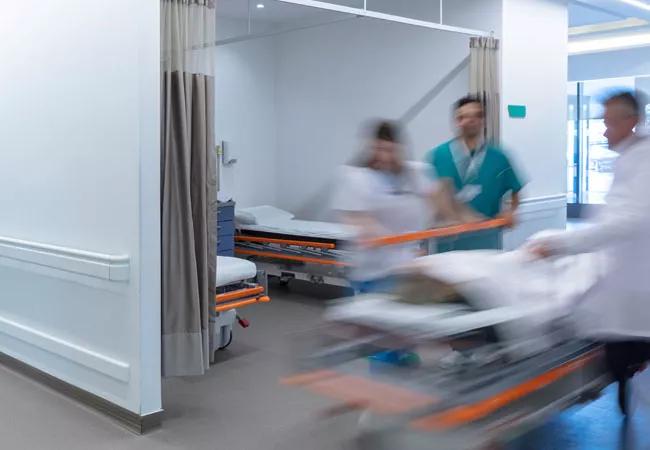The pandemic poses multiple potential delays to swift treatment initiation

By Murali K. Kolikonda, MBBS; M. Shazam Hussain, MD; and Ken Uchino, MD
Advertisement
Cleveland Clinic is a non-profit academic medical center. Advertising on our site helps support our mission. We do not endorse non-Cleveland Clinic products or services. Policy
Management of acute stroke is challenging under normal circumstances, but a confluence of factors related to the COVID-19 pandemic has made it particularly challenging in recent weeks in the United States.
Beyond affecting more than 1.2 million people worldwide as of this writing, the COVID-19 pandemic is exerting real but poorly understood impacts on the treatment of other medical emergencies, including acute stroke. Some of these effects are illustrated by two cases managed by Cleveland Clinic’s Cerebrovascular Center in the first weeks after the pandemic’s emergence in Northeast Ohio.
Case 1. One patient called emergency medical services after nine days of experiencing symptoms of aphasia and right hemiparesis. During evaluation on our mobile stroke treatment unit, the patient was asked about the long delay in seeking care and responded that it was due to being “afraid to come out due to the coronavirus.”
Case 2. A second patient was transferred to Cleveland Clinic for mechanical thrombectomy after presenting with right middle cerebral artery syndrome. She had a history of flu-like symptoms over the prior 10 days. In view of these symptoms, the patient was managed as if she had possible COVID-19 and precautionary measures were taken, which included intubation prior to thrombectomy, to prevent aerosol spread, and the use of personal protective equipment (N95 respirators, surgical masks, gowns and protective eyewear) for all providers in the procedure room. As a result, treatment initiation was delayed.
Advertisement
These cases echo reports from other centers, which include instances where members of stroke care teams have had to be quarantined and/or have tested positive for the virus that causes COVID-19, severe acute respiratory syndrome coronavirus 2 (SARS-CoV-2), after exposure to stroke patients infected with the virus.
Indeed, a number of factors related to the COVID-19 pandemic are resulting in potential delays to the swift treatment that is essential to optimal stroke outcomes:
These factors collectively represent a perfect storm that may make acute stroke management more challenging — and optimal patient outcomes more difficult to achieve — as long as the COVID-19 pandemic persists.
As healthcare organizations tend to the surge of COVID-19 cases, we must be vigilant about preserving the quality of care for stroke and other acute illnesses and also about striking the right balance between patient care and protection of healthcare workers. We must recognize that some treatment delays will be inevitable to ensure the proper protection and safety of providers treating patients with acute disease. And we must continue to educate the public about the importance of seeking immediate medical attention for symptoms suggesting stroke or other acute medical emergencies.
Advertisement
Cleveland Clinic’s Cerebrovascular Center has developed a strategic plan to triage and prescreen patients for COVID-19 symptoms, alert the necessary teams and have personal protective equipment readily available when the patient hits the door. However, we remain mindful of the priority that must be given to provider safety in order to avoid depleting the healthcare workforce during a crisis when our communities need providers more than ever.
For a more detailed take on the issues discussed here, see the authors’ commentary on Neurology® Blogs.
References
Dr. Kolikonda is a vascular neurology fellow at Cleveland Clinic. Dr. Hussain is Director of Cleveland Clinic’s Cerebrovascular Center, and Dr. Uchino is Head of Research and Education in the Cerebrovascular Center.
Advertisement
Advertisement

Patients report improved sense of smell and taste

Clinicians who are accustomed to uncertainty can do well by patients

Unique skin changes can occur after infection or vaccine

Cleveland Clinic analysis suggests that obtaining care for the virus might reveal a previously undiagnosed condition

As the pandemic evolves, rheumatologists must continue to be mindful of most vulnerable patients

Early results suggest positive outcomes from COVID-19 PrEP treatment

Could the virus have caused the condition or triggered previously undiagnosed disease?

Five categories of cutaneous abnormalities are associated with COVID-19